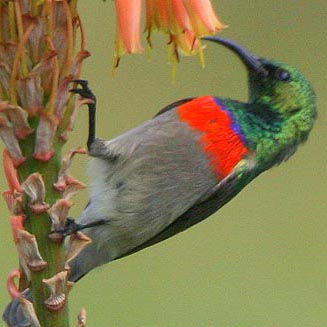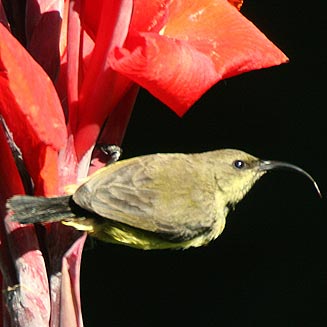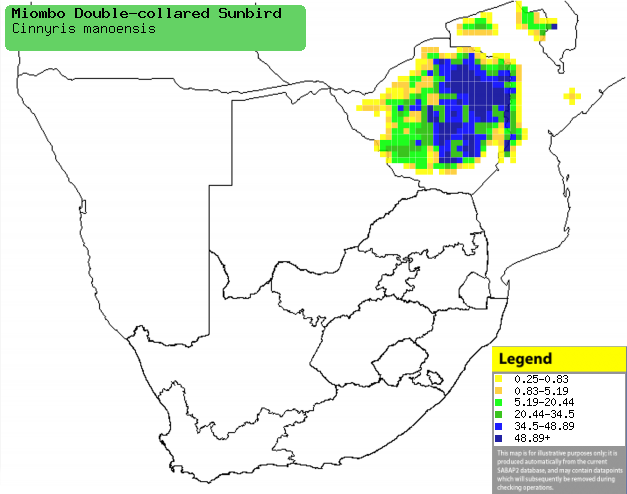|
Cinnyris manoensis (Miombo
double-collared sunbird)
[= Nectarinia manoensis]
Miombo-rooibandsuikerbekkie [Afrikaans]; Dzonya, Tsodzo
(both are generic names for sunbird) [Shona]; Miombo-honingzuiger [Dutch];
Souimanga du miombo [French]; Miombonektarvogel [German]; Beija-flor-do-miombo
[Portuguese]
Life
> Eukaryotes >
Opisthokonta
> Metazoa (animals) >
Bilateria >
Deuterostomia > Chordata >
Craniata > Vertebrata (vertebrates) > Gnathostomata (jawed
vertebrates) > Teleostomi (teleost fish) > Osteichthyes (bony fish) > Class:
Sarcopterygii (lobe-finned
fish) > Stegocephalia (terrestrial
vertebrates) > Tetrapoda
(four-legged vertebrates) > Reptiliomorpha > Amniota >
Reptilia (reptiles) >
Romeriida > Diapsida > Archosauromorpha > Archosauria >
Dinosauria
(dinosaurs) > Saurischia > Theropoda (bipedal predatory dinosaurs) >
Coelurosauria > Maniraptora > Aves
(birds) >
Order: Passeriformes > Family: Nectariniidae
 |
 |
|
Miombo double-collared sunbird male, Ewanrigg
Botanical Gardens, Zimbabwe. [photo
Ian Nason ©] |
Miombo double-collared sunbird female, Amanzi
Lodge, Harare, Zimbabwe. [photo
Ian Nason ©] |
Distribution and habitat
Occurs in patches from Tanzania through Malawi, northern
Mozambique, Zambia and Angola to southern Africa. Here it is common across much
of Zimbabwe, generally preferring miombo (Brachystegia) woodland but also
occupying montane habitats, such as patches of pincushions (Leucospermum),
Erica and Protea scrub, well wooded gardens and Acacia
savanna (especially in winter when mistletoes are flowering).
|
 |
|
Distribution of Miombo double-collared sunbird in southern Africa,
based on statistical smoothing of the records from first SA Bird Atlas
Project (©
Animal Demography unit, University of
Cape Town; smoothing by Birgit Erni and Francesca Little). Colours range
from dark blue (most common) through to yellow (least common). |
Predators and parasites
It has been recorded as prey of the Domestic cat (Felis
cattus).
Food
It mainly eats nectar supplemented with arthropods,
gleaning them from foliage and hawking prey aerially. The following food items have been recorded
in its diet:
- Nectar
- Loranthaceae (mistletoes)
- Tecoma capensis (Cape honeysuckle)
- Leonotis (wild dagga)
- Gladiolus dalenii (African gladiolus)
- Holmskioldia (Chinese lanterns)
- Aloe arborescens (Krantz aloe)
- Aloe cameronii (Cameron's ruwari aloe)
- Kniphofia (torch lilies)
- Bauhinia variegata (Butterfly tree)
- Callistemon viminalis (alien Bottlebrush)
- Arthropods
Breeding
- The nest is built solely by the female in at least a week, consisting of a
thick-walled oval-shaped structure made of forbs, shredded bark, dry leaves
and fine grass, bound together with spider web. The entrance hole is
positioned on the side, sometimes covered by a hood made of dry grass, while
the interior is lined with feathers and plant down. It is typically
suspended from a branch near a mass of spider webs, or occasionally beneath
a house porch or building overhang.
- Egg-laying season is year-round, peaking from August-November.
- It lays 1-3 eggs, which are incubated solely by the female for
approximately 14-16 days.
- The chicks are mainly fed by the female, leaving the nest after about
13-15 days, remaining dependent on their parents for at least one more week.
Threats
Not threatened.
References
-
Hockey PAR, Dean WRJ and Ryan PG 2005. Roberts
- Birds of southern Africa, VIIth ed. The Trustees of the John Voelcker
Bird Book Fund, Cape Town.
|
